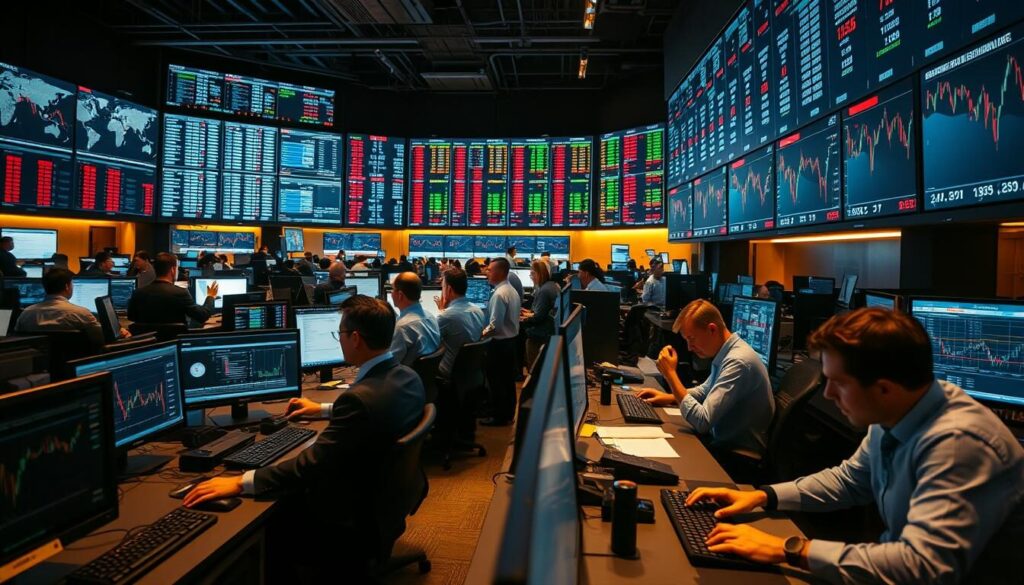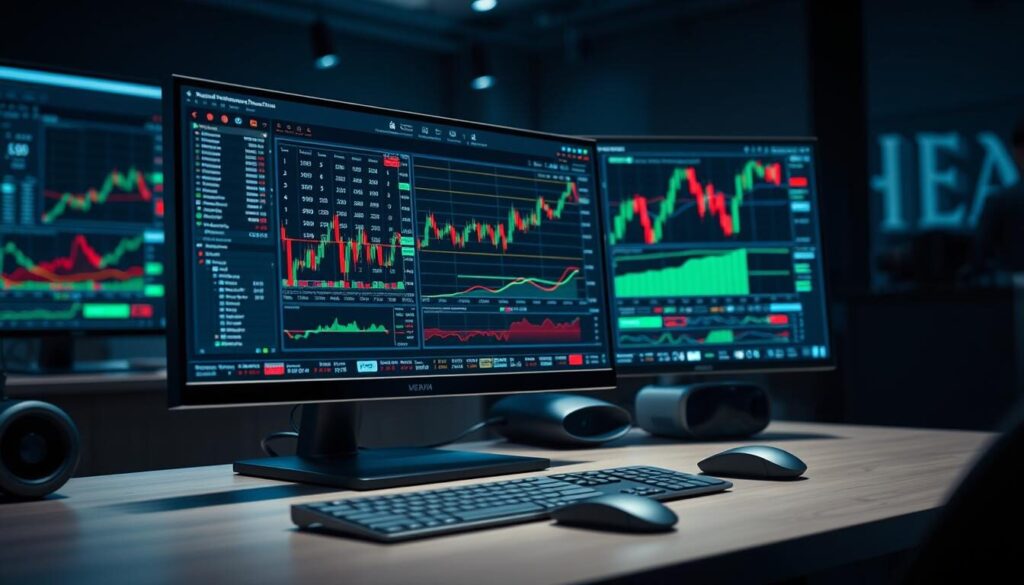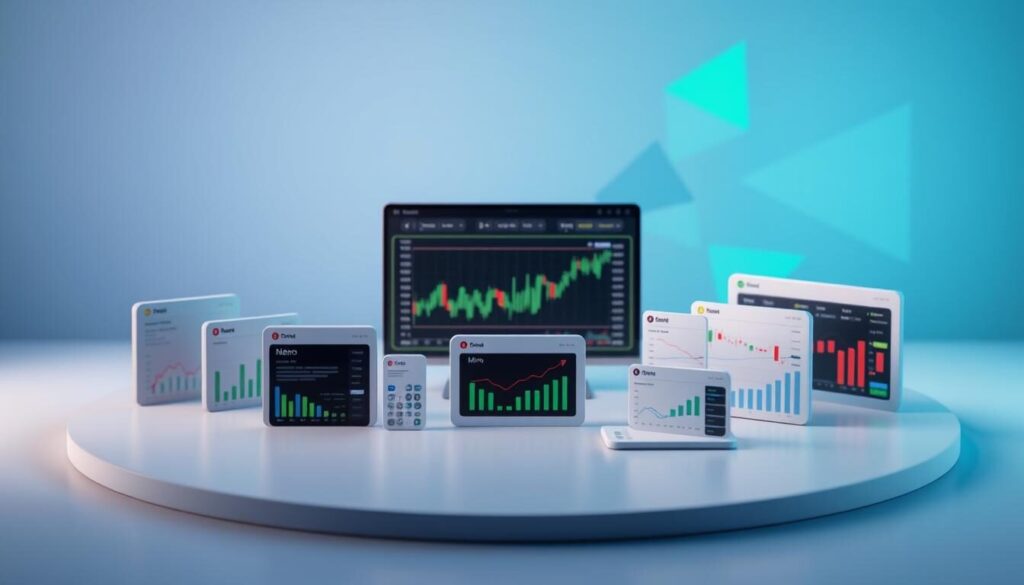Picture every coffee, burger, and streaming subscription bought globally in a day. Now multiply that by 100. That’s the foreign exchange market – where $7.5 trillion changes hands daily. But here’s the twist: you’re not trading directly with banks. Enter the middlemen wearing digital capes.
Forex brokers are like the Alfred to your Batman, connecting retail traders to the interbank system’s liquidity. They provide the trading platform where currencies dance in pairs – EUR/USD, GBP/JPY – while skimming their cut from the spread difference between buy/sell prices. Think of it as paying tolls on a financial highway.
Some charge commissions like VIP lane fees. Others widen spreads like sneaky airport currency kiosks. Even “commission-free” brokers profit – imagine Spider-Man charging you in invisible web fibers. This currency trading and forex brokers dynamic shapes every trade’s success.
Why care? Because your broker isn’t just a tool – they’re your dance partner in this 24/7 money tango. Messy footwork (read: hidden fees) means stepped-on toes (read: vanishing profits).
Key Takeaways
- The forex market trades over $7.5 trillion daily – 3x global stock markets combined
- Brokers bridge retail traders and institutional liquidity providers
- Revenue comes from spreads (bid/ask gaps) and/or direct commissions
- “Commission-free” often means wider spreads – math matters
- Platform reliability and execution speed impact trade outcomes
- Understanding brokerage models helps minimize hidden costs
Introduction to Forex Brokers and the Market
Imagine trying to hail a taxi in 1970s New York versus tapping Uber today. That’s the leap retail traders made when online platforms replaced phone-based currency deals. The market’s $7.5 trillion daily dance became accessible to anyone with Wi-Fi.
Brokers act as digital bridges. They plug your trading account into rivers of liquidity flowing from banks and institutions. Like translating Shakespeare into emojis, they convert institutional-grade data into usable buy/sell buttons on your screen.
Here’s how it evolved: The 1971 Bretton Woods collapse turned currencies into free agents. Suddenly, exchange rates floated like TikTok trends. Fast-forward to 1996 – MetaTrader’s birth let traders swap yen for euros while wearing pajamas.
Modern platforms aggregate prices like Yelp reviews. Five liquidity providers bid on EUR/USD? Your broker shows the juiciest spread. One bank offers 1.12044, another 1.12045? You get the better rate – usually.
“Tight spreads aren’t charity,” says a Wall Street veteran. “They’re loss leaders for brokers – like free chips before margarita night.”
Choose transparency. NerdWallet’s 2023 study found brokers with clear pricing help traders avoid hidden costs. Next, we’ll dissect how these middlemen actually turn profits – spoiler: it’s not just from your winning trades.
How do forex brokers work in the Real World

Think of opening a trade like sprinting into a Marvel movie premiere – your forex broker is both the ticket scalper and the bouncer. When you click “buy” on EUR/USD, they’re not just executing your order. They’re playing financial Tetris, matching your position against other traders or swallowing it themselves.
Here’s the twist: that price you see? It’s like a mirage. Brokers often tweak quotes during news events – imagine Spider-Man shooting webs to slow your order while he adjusts his own spread. One trader’s 2023 log shows GBP/USD quotes shifting 0.0005 in milliseconds during Brexit updates.
| Scenario | Spread | Profit/Loss per $10k |
|---|---|---|
| Calm Market | 1.2 pips | +$12 |
| Fed Announcement | 5.8 pips | -$46 |
| Weekend Gap | 23 pips | -$230 |
Liquidity crumbles like stale cookie during crises. Remember 2015’s “Swiss Shock”? One currency pair (EUR/CHF) dropped 30% in minutes. Brokers froze accounts faster than Thanos snapped fingers – leaving traders holding empty digital bags.
“We’re not villains,” insists a broker rep. “But if clients win big during chaos, our risk models hemorrhage red ink.” That’s why margin calls hit faster than TikTok trends when volatility spikes.
Pro tip: Always check live market prices elsewhere. Your trading account screen might show EUR/USD at 1.0850 while real-world data says 1.0845. That 0.0005 difference? That’s the house edge – Vegas rules apply.
Master these dynamics, and you’ll navigate currency swings like Black Widow dodging bullets. Next up: decoding fee structures that could make your wallet scream.
Broker Fee Structures and Hidden Costs
Ever bought concert tickets where the ‘convenience fee’ cost more than the actual seat? Welcome to forex pricing. Brokers monetize trades two ways: through commissions (flat fees per transaction) or spreads (the gap between buy/sell prices). It’s like choosing between Netflix’s monthly subscription or Hulu’s ad-supported model – both get you the show, but the billing hits differently.
Understanding Commission and Spread Charges
Commission-based brokers act like VIP bouncers – $5 per lot traded, no surprises. Spread-focused ones? Think of them as sneaky parking meters. That EUR/USD quote showing 1.0850/1.0852? The 0.0002 difference is their cut. During calm markets, it’s pocket change. But when economic reports drop, spreads balloon like marshmallows in a microwave. A 2023 study found GBP/USD spreads jumped 400% during Bank of England announcements.
Fixed vs. Variable Spreads Explained
Fixed spreads are umbrellas in drizzle – predictable. You’ll always pay 1.5 pips for USD/JPY, rain or shine. Variable spreads? More like surfing during a hurricane. They shrink to 0.8 pips at 3 AM, then spike to 5 pips when Trump tweets about tariffs. One trader’s log shows a $12 profit turning into a $47 loss just from spread widening.
| Fee Type | Calm Market Cost | Volatility Cost |
|---|---|---|
| Fixed Spread | $15 per $10k | $15 per $10k |
| Variable Spread | $8 per $10k | $50 per $10k |
Watch for “commission-free” traps – they’re like free apps selling your data. Brokers recoup costs through wider spreads or inactivity fees. Always compare live quotes with independent sources. Your platform might show EUR/USD at 1.0849 while real-time data screams 1.0845. That 0.0004 gap? That’s the broker’s silent high-five.
Trading Platforms and Order Execution

Ever been stuck at a traffic light that turns red just as you approach? That’s slippage in trading – the gap between your expected price and where your order actually fills. Platforms act like GPS for currency trades, but even Waze can’t predict every market pothole.
Mirror or Mirage?
Your screen shows EUR/USD at 1.0850. You click buy. Three things happen faster than a TikTok scroll:
- The platform pings liquidity providers
- Snags the best available price
- Executes your trade (or doesn’t)
During calm markets, it’s smooth sailing. But when economic data drops? Prices jump like popcorn. A 2023 MiFID II report showed 63% of EUR trades faced slippage during ECB announcements – averaging 1.7 pips per $10k lot.
| Platform Type | Avg. Slippage | Execution Speed | Transparency |
|---|---|---|---|
| ECN | 0.8 pips | 82 ms | High |
| Market Maker | 2.3 pips | 210 ms | Mixed |
| STP | 1.1 pips | 95 ms | Moderate |
Taming the Speed Demon
Order delays are the silent profit killers. Imagine shouting your coffee order at Starbucks during peak hour – baristas might hear “latte” as “mocha.” Same with platforms during volatility. “Execution quality separates hobbyists from pros,” says a hedge fund tech lead. “We test brokers like crash-test dummies.”
Three rules to avoid slippage whiplash:
- Use limit orders – set your price ceiling like an Uber surge cap
- Avoid news spikes – trading NFP reports is like dating during cuffing season
- Check broker stats – MiFID II requires public execution reports (your new best friend)
Pro tip: Run platform speed tests using demo accounts. If your “instant” order takes longer than microwave popcorn? Swipe left.
Risk Management and Counterparty Credit Concerns

Imagine trusting Spider-Man to catch you mid-swing, only to realize his web fluid’s expired. That’s counterparty credit risk in trading – your broker’s ability to honor trades when markets go full Thanos. Every currency pair you trade is a handshake agreement: you win, they pay. But what if their vault’s empty?
Brokers act as financial safety nets. They’re supposed to cover losses if markets implode. But during the 2015 Swiss Franc chaos, some platforms folded faster than origami cranes. Traders woke up to negative balances – owing money because their “Spider-Man” couldn’t absorb the shock.
Three red flags to spot shaky partners:
- Margin requirements lower than a limbo stick (0.5% instead of 2-5%)
- Prices that lag real-time data like a buffering Netflix show
- Vague answers about liquidity providers – “trust us” isn’t a strategy
Lehman Brothers’ 2008 collapse left traders dangling like Spider-Man without webs. Those with segregated accounts got rescued. Others? Let’s just say their portfolios needed CPR. “Capitalization matters more than a flashy platform,” warns a CFTC auditor. “Check their financials like you’d inspect a parachute before jumping.”
Protect your trades:
- Use stop-loss orders – automatic eject buttons for bad positions
- Diversify across regulated brokers (don’t put all webs in one shooter)
- Verify segregation of client funds – your money shouldn’t mingle with theirs
Remember: Risk management isn’t sexy. It’s the seatbelt in your trading car. Skip it, and even profitable strategies can crash harder than a meme stock.
Liquidity, Account Types, and Execution Models

Choosing a trading account feels like picking between a mall food court and a chef’s kitchen. Both feed you, but the ingredients and experience differ wildly. Your selection determines whether you get reheated spreads or fresh market prices.
Dealing Desk vs. Non-Dealing Desk Brokers
Dealing desk brokers are the fast-food chains of finance. They cook up their own prices like secret sauce recipes, acting as your direct counterparty. Need to sell EUR/USD? They’ll buy it – but set the spread wider than a Texas highway. Pros? Instant order fills. Cons? Potential conflicts when you profit.
Non-dealing desk platforms work like food delivery apps. They connect you to multiple market kitchens (liquidity providers) for better pricing. One trader’s log shows USD/JPY spreads averaging 0.8 pips with NDD vs. 1.5 pips at DD brokers during Tokyo sessions.
| Model | Spread (EUR/USD) | Execution Speed | Conflict Risk |
|---|---|---|---|
| Dealing Desk | 1.5 pips | Instant | High |
| Non-Dealing | 0.9 pips | 82 ms | Low |
ECN, STP, and Hybrid Account Types
ECN accounts are the stock exchange apps of currency trading. You see real price bids from banks globally. Perfect for scalpers needing razor-thin spreads. But they charge commissions – like paying cover charges at exclusive clubs.
- STP accounts: Automated drive-thrus. Orders route directly to liquidity providers without human grease stains
- Hybrid models: Buffet-style trading. Combines STP speed with some DD flexibility
“ECN saved my scalping strategy,” admits a Reddit day trader. “But the $3 commission per lot adds up faster than TikTok views.”
Liquidity droughts turn even good accounts into mirages. When the Fed speaks, EUR/USD spreads can jump from 0.6 to 4 pips – enough to vaporize profits. Always match your account type to your strategy: ECN for precision, STP for consistency, hybrid for versatility.
Leveraging Technology in Modern Forex Trading

Modern currency trading tech is like swiping right on Tinder – miss a millisecond, and your perfect match (trade) ghosts you. Platforms now crunch data faster than a TikTok algorithm, turning chaotic market waves into actionable signals. Remember dial-up internet? That’s what trading without today’s tools feels like.
Brokers armed with AI act like GPS for your money. One Reddit trader shared: “My algo spotted a EUR/USD dip before Bloomberg tweeted – cha-ching!” These systems scan 50+ currency pairs simultaneously, flagging opportunities faster than you can say “FOMO.”
Mobile apps turn phones into trading hubs. Imagine closing a USD/JPY deal while waiting for coffee – no desktop needed. But laggy tech? That’s financial quicksand. A 2023 study showed traders using outdated platforms missed 37% more profitable exits during Fed speeches.
| Tech Feature | Stone Age | Now |
|---|---|---|
| Order Execution | 2.1 seconds | 0.08 seconds |
| Price Updates | Every 5 sec | 500x/sec |
| Risk Alerts | Manual | AI-powered |
Single account access to stocks, crypto, and oil? That’s today’s norm. Diversify your portfolio while binge-watching Netflix. But here’s the kicker: smart tools don’t just prevent losses – they’re profit engines. One platform’s volatility scanner boosted user returns by 22% last quarter.
Still, tech fails sting. Picture this: You spot a GBP/USD surge, hit “buy,” and… nothing. Your app froze like a Windows 98 update. By the time it reboots, the spread widened enough to erase gains. Lesson? Always have a backup device – and maybe avoid trading during family Zoom calls.
Staying competitive means embracing these digital sidekicks. Because in trading, you’re either Tony Stark with Jarvis… or the guy still renting Blockbuster DVDs.
Conclusion
Imagine gearing up for a heist movie finale – your broker’s the tech whiz ensuring smooth exits when alarms blare. They’re your gateway to the $7.5 trillion currency playground, where spreads and commissions decide whether you drive off in a Lambo or a stolen bicycle.
Smart traders treat brokers like dance partners, not ATMs. That account type you choose? It’s the difference between tap shoes and moonwalking sneakers. ECN models slice spreads like laser cutters, while STP platforms offer training wheels for newbies.
Here’s the loot: Check live price feeds against your platform. Compare slippage stats like Yelp reviews. And never let shiny tech distract from the basics – segregated funds and stop-loss orders are your financial seatbelts.
Now go be Danny Ocean with charts. Use this intel to spot sneaky fees hiding in market shadows. Because in trading, knowledge isn’t just power – it’s the difference between “retire by 40” and “explaining margin calls to your cat.”
FAQ
What exactly do forex brokers do?
Why does the bid/ask spread matter?
Can brokers manipulate prices against traders?
What’s the difference between ECN and standard accounts?
How do slippage and requotes happen?
What’s the real risk of using high leverage?
FAQ
What exactly do forex brokers do?
They act as middlemen between you and the interbank market – like a car dealership connecting buyers to manufacturers. Brokers provide trading platforms, leverage, and price quotes while earning through spreads or commissions. Your trades get routed to liquidity providers behind the scenes.
Why does the bid/ask spread matter?
That spread difference is your instant transaction cost. Imagine buying concert tickets where the reseller pockets between what you pay and what sellers receive. Variable spreads widen during volatility (like news events), while fixed spreads stay predictable but often cost more overall.
Can brokers manipulate prices against traders?
Reputable brokers use straight-through processing (STP) to send orders directly to banks. But with “market maker” models, brokers take the other side of your trade – creating potential conflicts. Always check execution reports and regulator filings to verify fair practices.
What’s the difference between ECN and standard accounts?
ECN accounts connect you directly to other traders/institutions, charging commissions but offering razor-thin spreads. Standard accounts use the broker’s liquidity pool – simpler for beginners but with wider markups. It’s like choosing between a farmers’ market (ECN) and supermarket (standard).
How do slippage and requotes happen?
When prices move faster than orders execute, you get slippage – like clicking “buy” on Amazon only to see the price jump before checkout. Brokers with poor liquidity struggle to fill orders at requested prices, causing delays or worse rates. Look for brokers with
What’s the real risk of using high leverage?
Leverage amplifies both gains and losses – it’s like riding a motorcycle at 200mph without training. While 500:1 leverage lets you control 0k with
FAQ
What exactly do forex brokers do?
They act as middlemen between you and the interbank market – like a car dealership connecting buyers to manufacturers. Brokers provide trading platforms, leverage, and price quotes while earning through spreads or commissions. Your trades get routed to liquidity providers behind the scenes.
Why does the bid/ask spread matter?
That spread difference is your instant transaction cost. Imagine buying concert tickets where the reseller pockets $5 between what you pay and what sellers receive. Variable spreads widen during volatility (like news events), while fixed spreads stay predictable but often cost more overall.
Can brokers manipulate prices against traders?
Reputable brokers use straight-through processing (STP) to send orders directly to banks. But with “market maker” models, brokers take the other side of your trade – creating potential conflicts. Always check execution reports and regulator filings to verify fair practices.
What’s the difference between ECN and standard accounts?
ECN accounts connect you directly to other traders/institutions, charging commissions but offering razor-thin spreads. Standard accounts use the broker’s liquidity pool – simpler for beginners but with wider markups. It’s like choosing between a farmers’ market (ECN) and supermarket (standard).
How do slippage and requotes happen?
When prices move faster than orders execute, you get slippage – like clicking “buy” on Amazon only to see the price jump before checkout. Brokers with poor liquidity struggle to fill orders at requested prices, causing delays or worse rates. Look for brokers with
What’s the real risk of using high leverage?
Leverage amplifies both gains and losses – it’s like riding a motorcycle at 200mph without training. While 500:1 leverage lets you control $500k with $1k, a 0.2% price move wipes your account. Smart traders use stop-loss orders and risk ≤1% per trade.
Are swap fees worth considering?
Absolutely. Holding positions overnight incurs swap charges based on interest rate differences between currencies. It’s like paying a hotel resort fee – hidden but adds up. Some brokers offer swap-free accounts (with wider spreads) for religious or strategic reasons.
k, a 0.2% price move wipes your account. Smart traders use stop-loss orders and risk ≤1% per trade.
Are swap fees worth considering?
Absolutely. Holding positions overnight incurs swap charges based on interest rate differences between currencies. It’s like paying a hotel resort fee – hidden but adds up. Some brokers offer swap-free accounts (with wider spreads) for religious or strategic reasons.
